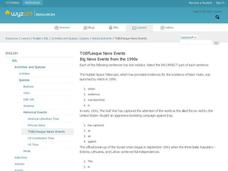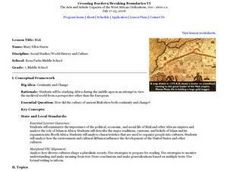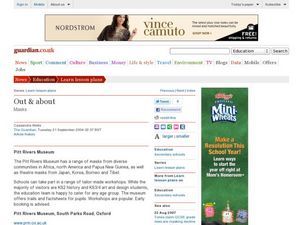Curated OER
Spy on a Spider
Students view slides or live specimens to name and describe the distinguishing features of groups of arthropods, especially spiders and insects. They complete worksheets, observe webs and then search for and record where spiders can be...
Curated OER
Creatures from Planet X: Spiders
Students are given a description of some fascinating animals from "Planet X". They follow the descriptions given to illustrate one of these animals paying careful attention to introduced vocabulary such as 'appendages', 'receptors', and...
Curated OER
Facts, Feats and Folklore: Spiders
Students review and discuss a variety of sayings, folklore and superstitions about spiders. They discuss this information and choose either an interesting fact or appealing foklore tradition to illustrate.
Curated OER
Letters from the Japanese American Internment
Young scholars make deductions about life in an internment camp by reading and comparing letters written to Clara Breed. Along the way, they consider the advantages of looking at a historical event from the multiple points of view of...
Curated OER
Regions of South America
Students explore facts about South America in the four lessons of this unit. Booklets are created from the materials produced as the class delves into the topic.
Curated OER
Great Britain's Greatest Queen
Fourth graders explore the reign of Queen Victoria and the significant political developments in the 19th century.
Curated OER
The U.S. Recognition of the State of Israel
Students research the political aspects of the U.S. position in the Middle East, considering, for example, Truman's position in view of the 1948 presidential election. They examine a telegram sent by the Secretary of State, George C....
Curated OER
Guidelines for Governing: Utopia and The Prince
Students explore the power of the Church in government. In this literature lesson, students read Sir Thomas More's Utopia and Niccolo Machiavelli's The Prince. Students respond to questions regarding the works and discuss them.
Curated OER
Working Watermelon
You're going to wish you had a watermelon for this lesson! Class members read about watermelons and make a salad in class to sample. They also perform estimates, measurements and calculations on a watermelon. They predict what percentage...
Curated OER
Developing Civilizations and the Role of Rice
Student investigate how civilizations developed. In this rice farming lesson, 5th graders explore how rice cultivation changed through different civilizations. Students gain knowledge about different types of rice, where it's grown and...
Curated OER
The Art of El Anasui: Creating a Mural with Discarded/Recycled Objects
Students create murals that feature recycled objects. In this West African art lesson, students examine artwork by El Anatsui and his commentary on social issues. Students then create murals in the style of El Anatsui using discarded...
Curated OER
Ancient Egypt
In this Ancient Egypt worksheet, students read a 2 page article on Ancient Egypt, answer 3 statements as true or false and choose which multiple choice answers best answers 3 questions/statements.
Curated OER
TOEFLesque Quiz: Big News Events from the 1990s
In this online interactive grammar skills lesson, students examine 10 sentences and identify the part of each sentence that is grammatically incorrect.
Curated OER
Contemporary Immigration
Eleventh graders analyze the patterns and waves of immigrants that have come to the United States from 1850 to 2000. They participate in a class discussion about immigration, and in small groups conduct research analyzing and evaluating...
Curated OER
Mali
Seventh graders begin the lesson by reading primary sources about the country of Mali. Using maps drawn in the past, they discuss what they can gather about the country from the map and how it has changed over time. They use a graphic...
Curated OER
SAT Reading Comprehension Practice Test 07
In this reading comprehension worksheet, students read an extract from Darwin's book The Voyage of the Beagle. Students answer 12 comprehension questions in 15 minutes in this SAT practice worksheet.
Curated OER
Out and About: Masks
Learners investigate the art of mask-making. In this cultural masks lesson, students may visit the Hancock or Horniman Museums in Britain online or in-person to discover details about cultural masks and give a try at making their own.
Curated OER
Coming to America: A Look at Colonization in the 1600s
Students analyze the European colonization of America. In this colonial America lesson, students use provided Internet resources to research colonization and representative government. Students use their finding to create webpages,...
Curated OER
Scientists and Inventors
Students explore human discovery by reading historical stories in class. In this inventors lesson, students define the terms scientist, invention, inventor and discovery before discussing the many differences between them. Students read...
Curated OER
Cave Art: Discovering Prehistoric Humans through Pictures
Students explore how people in earlier times used art as a way to record stories and communicate ideas. By studying paintings from the Cave of Lascaux and other caves in France, students discover that pictures are more than pretty colors.
Curated OER
What's Rome Got to Do With it?
Sixth graders examine the government of ancient Rome as well as their home country. They discover the basic structure of the government of Rome, their country, and another country.
Curated OER
African-American Art and the Political Dissent during the Harlem Renaissance
Pupils are introduced to the culture of African American art. Using the internet, they research the events surrounding the Harlem Renaissance and discover how it produced a wide variety of art and literature. To end the lesson, by...
Curated OER
The Story Of American Freedom
Learners investigate the concept of American freedom with the use of primary sources of images in order to derive meaning. The images are used to inspire research and writing about historical scenes. The writing and analysis of the...
Curated OER
Follow That Ship!
Students in this exercise are introduced to the distinct ways of measuring distance (nautical miles) and speed (knots) at sea, as well as the concepts of latitude and longitude for establishing location.

























